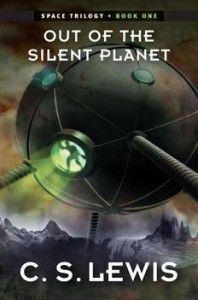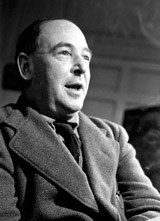 About Out of the Silent Planet
About Out of the Silent Planet
• File Size: 365 KB
• Publisher: HarperOne (April 3, 2012)
Just as readers have been transfixed by the stories, characters, and deeper meanings of Lewis’s timeless tales in The Chronicles of Narnia, most find this same allure in his classic Space Trilogy. In these fantasy stories for adults, we encounter, once again, magical creatures, a world of wonders, epic battles, and revelations of transcendent truths.
Out of the Silent Planet is the first novel in C. S. Lewis’s classic science fiction trilogy. It tells the adventure of Dr. Ransom, a Cambridge academic, who is abducted and taken on a spaceship to the red planet of Malacandra, which he knows as Mars. His captors are plotting to plunder the planet’s treasures and plan to offer Ransom as a sacrifice to the creatures who live there. Ransom discovers he has come from the “silent planet”—Earth—whose tragic story is known throughout the universe!
About C.S. Lewis
Clive Staples Lewis (1898–1963) was one of the intellectual giants of the 20th century and arguably the most influential Christian writer of his day. His major contributions in literary criticism, children’s literature, fantasy literature, and popular theology brought him international renown and acclaim. He wrote more than thirty books, allowing him to reach a vast audience, and his works continue to attract thousands of new readers every year. His most distinguished and popular accomplishments include The Chronicles of Narnia, Out of the Silent Planet, The Four Loves, The Screwtape Letters, and Mere Christianity.
C. S. Lewis was born in Belfast, Ireland, on November 29, 1898, to Albert J. Lewis and Florence Augusta Hamilton Lewis. Throughout his life, Lewis was known to his family and friends as “Jack”—a nickname he coined for himself at the age of four after the beloved neighborhood dog Jacksie died. Lewis had one brother, Warren Hamilton Lewis (1895–1973). Lewis’s mother died of cancer in 1908 when he was just nine years old.
In 1910, Lewis became a boarding student at Campbell College in Belfast, just one mile from his home, but withdrew one year later. In 1913, Lewis enrolled at Malvern College, where he remained for one year. It was there that, at age fifteen, he became an atheist, abandoning the Christian faith of his childhood. From Malvern, he went into private tutoring under William T. Kirkpatrick, “The Great Knock,” who had also been his father’s tutor.
Lewis went on to receive a scholarship to University College, Oxford, in 1916. Lewis took a hiatus from study after the outbreak of WW I, enlisting in the British Army in 1917. On April 15, 1918, Lewis was wounded in the Battle of Arras and was discharged a little more than a year later in December 1919.
While in the army, Lewis became close friends with his roommate Paddy Moore. Moore was killed in battle in 1918. After Lewis was discharged, he followed through with a promise to his friend to look after Moore’s family. Lewis moved in with Paddy’s mother, Jane Moore, and her daughter, Maureen, in 1920. The three of them eventually moved into “The Kilns,” which they purchased jointly along with Lewis’s older brother, Warren.
On May 20, 1925, Lewis was appointed Fellow and Tutor in English Literature at Oxford University, where he served for twenty-nine years until 1954.
During his time at Oxford, Lewis went from being an atheist to being one of the most influential Christian writers of the 20th century; 1931 marks the year of Lewis’s conversion to Christianity. He became a member of the Church of England. Lewis cites his friendship with J. R. R. Tolkien, as well as the writings of the converted G. K. Chesterton, as influencing his conversion.
Also while at Oxford, Lewis was the core member of the now famous literary group “The Inklings.” This group was an informal twice-weekly gathering of friends which included Tolkien, Hugo Dyson, Charles Williams, Dr. Robert Havard, Owen Barfield, and Nevill Coghill, among others. The meetings took place on Mondays and Thursdays. Monday meetings were held at a handful of local pubs, including The Eagle and Child, known to locals as The Bird and Baby and The Lamb and Flag. Thursday meetings were held in Lewis’s rooms.
Lewis was married late in life at age fifty-eight to Joy Davidman Gresham, an American writer fifteen years his junior. They married in 1956, two years after Lewis accepted the chair of Medieval and Renaissance Literature at Cambridge, where he finished out his career.
After a four-year fight with bone cancer, Joy passed away in 1960. Lewis continued to care for her two sons, Douglas and David Gresham.
C. S. Lewis died at his home, “The Kilns,” on November 22, 1963. His grave is in the yard of Holy Trinity Church in Headington Quarry, Oxford. Warren Lewis died on Monday, April 9, 1973. Their names are on a single stone bearing the inscription “Men must endure their going hence.”
Website | Facebook fan page | Twitter | Blog – Original work on and about C.S. Lewis
C.S.’s Tour Stops
Friday, April 6th: Just One More Paragraph
Wednesday, April 11th: Reflections of a Bookaholic
Saturday, April 14th: Unabridged Chick
Monday, April 16th: The Written World
Tuesday, April 17th: GeekMom
Wednesday, April 18th: Hooked on Books
Monday, April 23rd: The Road to Here
Wednesday, April 25th: Wyoming Girl *turned* Coastie Wife
Thursday, April 26th: Creative Madness Mama
Friday, April 27th: Calico Critic
Monday, April 30th: Working for the Mandroid